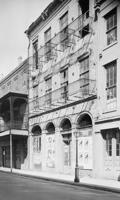Before it was a schoolhouse, the building that now houses Homer A. Plessy Community School was occupied by a theater linked to one of the city’s more persistent racial myths. Over the years, the site has also hosted both European royalty and rock-’n’-roll royalty.
Before it was a schoolhouse, the building that now houses Homer A. Plessy Community School was occupied by a theater linked to one of the city’s more persistent racial myths. Over the years, the site has also hosted both European royalty and rock-’n’-roll royalty.
Before it was a schoolhouse, the building that now houses Homer A. Plessy Community School was occupied by a theater linked to one of the city’s more persistent racial myths. Over the years, the site has also hosted both European royalty and rock-’n’-roll royalty.
It started with a fire, and a spectacular one at that, spraying a shower of otherworldly sparks and embers into the New Orleans night over the old Independent Laundries building in the Treme-Lafitte neighborhood shortly after 10 p.m. on Feb. 21, 1929.
Last week in this space, we chronicled the history of New Orleans’ famous Napoleon House, that building at Chartres and St. Louis streets that — as legend holds — was offered as a refuge for exiled French Emperor Napoleon Bonaparte as part of a broader scheme to rescue him from his island prison on St. Helena.
It was named after one of New Orleans’ most prominent civic activists of the 19th century. It was designed by one of the city’s most prominent public architects of the early 20th century. And it contains a series of celebrated murals painted in the 1930s as part of the Works Progress Administration.��
In this space last week, we described the old City Park carousel as “the go-to merry-go-round for locals.” But upon further review, that description needs a qualifier.��
Audubon Zoo’s Hurricane Ida-damaged carousel recently was removed for repairs, but there's another option in New Orleans for those determined to get dizzy. The go-to merry-go-round for most locals has been spinning its wheels in the city’s other major park for decades.��
For 300 years, mysteries of all sorts have abounded in the marshy patch of land between the Mississippi River and the shores of Lake Pontchartrain.










